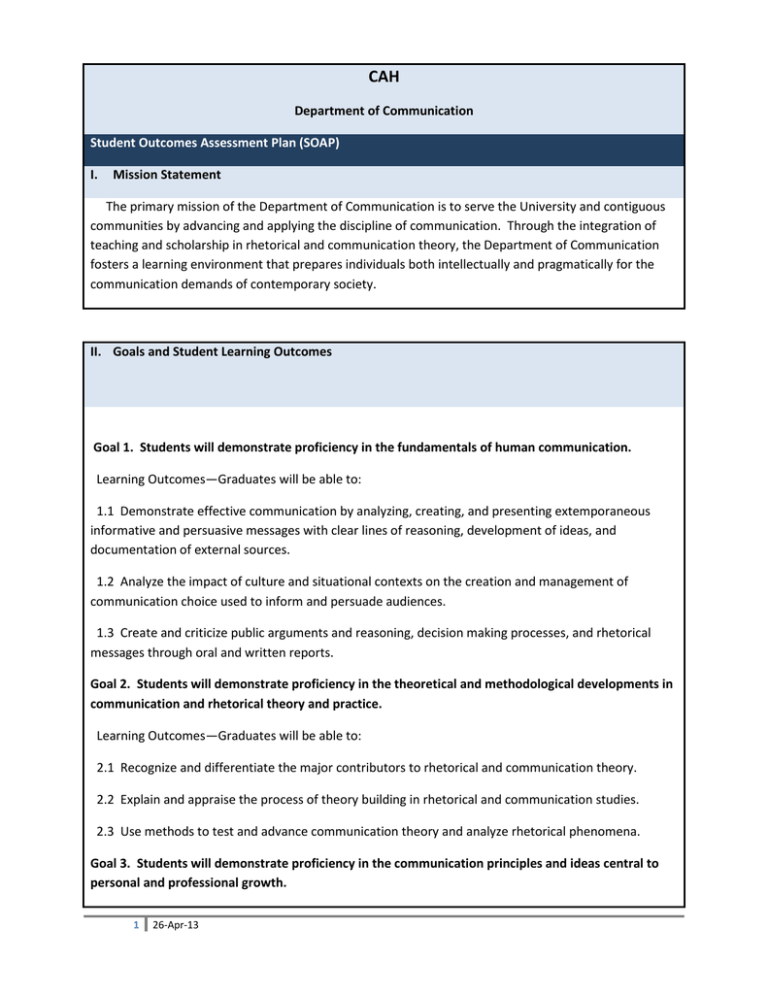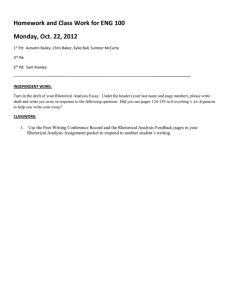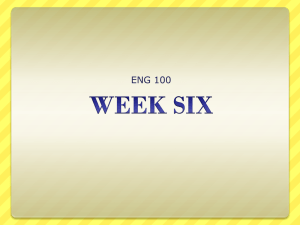CAH
advertisement

CAH Department of Communication Student Outcomes Assessment Plan (SOAP) I. Mission Statement The primary mission of the Department of Communication is to serve the University and contiguous communities by advancing and applying the discipline of communication. Through the integration of teaching and scholarship in rhetorical and communication theory, the Department of Communication fosters a learning environment that prepares individuals both intellectually and pragmatically for the communication demands of contemporary society. II. Goals and Student Learning Outcomes Goal 1. Students will demonstrate proficiency in the fundamentals of human communication. Learning Outcomes—Graduates will be able to: 1.1 Demonstrate effective communication by analyzing, creating, and presenting extemporaneous informative and persuasive messages with clear lines of reasoning, development of ideas, and documentation of external sources. 1.2 Analyze the impact of culture and situational contexts on the creation and management of communication choice used to inform and persuade audiences. 1.3 Create and criticize public arguments and reasoning, decision making processes, and rhetorical messages through oral and written reports. Goal 2. Students will demonstrate proficiency in the theoretical and methodological developments in communication and rhetorical theory and practice. Learning Outcomes—Graduates will be able to: 2.1 Recognize and differentiate the major contributors to rhetorical and communication theory. 2.2 Explain and appraise the process of theory building in rhetorical and communication studies. 2.3 Use methods to test and advance communication theory and analyze rhetorical phenomena. Goal 3. Students will demonstrate proficiency in the communication principles and ideas central to personal and professional growth. 1 26-Apr-13 Learning Outcomes—Graduates will be able to: 3.1 Identify the processes, strategies, and techniques influencing interpersonal and family relationships. 3.2 Explicate the communication processes influencing small group behavior. 3.3 Explain the role of leadership in group and professional settings. 3.4 Use theoretical perspectives to analyze and produce effective persuasive discourse. 3.5 Integrate theories of power, privilege, and difference into their understanding of communication behavior. Goal 4. Students will demonstrate competency in personal, narrative, and research writing. Learning Outcomes—Graduates will be able to: 4.1 Develop a thesis statement or research question that makes an arguable claim or addresses a relevant communication issue. 4.2 Utilize an organizational format that effectively develops an intended purpose. 4.3 Utilize appropriate language choice, sentence structure, and grammar. 4.4 Follow appropriate research style conventions (e.g. MLA or APA). III. Curriculum Map (Matrix of Courses X Learning Outcomes) Curriculum Map Goal 1 Courses 3, 7, 8 2 Outcome 1 Outcome 2 Outcome 3 x 26-Apr-13 x x Curriculum Map Goal 2 Courses Outcome 1 Outcome 2 Outcome 3 100 x x x 140 x x x 142 x x x 166 x x x Curriculum Map Goal 3 Courses Outcome 1 Outcome 2 Outcome 3 Outcome 4 Outcome 5 108 x 120 x 150 x 161 x 162 x x x x x 163 x 164 x x x x 167 x 168 x 169 x x 171 x x x x Curriculum Map Goal 4 Courses Outcome 1 Outcome 2 Outcome 3 100 x x x 140 x x x 142 x x x 166 x x x 3 26-Apr-13 x IV. Assessment Methods A. Direct Measures 1. Course Assignments (with scoring rubrics) 2. Examinations 3. Course Presentations (with scoring rubrics) B. Indirect Measures 1. Teaching Evaluations 2. Student Interviews 3. Post-graduate survey (every other year) V. Student Learning Outcomes X Assessment Methods Matrix Learning Outcome Course Assignments Exams Course Presentations Teaching Evaluations 1.1 x x x x 1.2 x x x x 1.3 x x x x 1.4 x x x x 2.1 x x 2.2 x x 2.3 x x 3.1 x x 3.2 x x 3.3 x x 4 26-Apr-13 x Learning Outcome Course Assignments Exams 3.4 x x 3.5 x x 4.1 x x 4.2 x x 4.3 x x 4.4 x x Course Presentations Teaching Evaluations VI. Timeline for Implementation of Assessment Methods and Summary Evaluations Communication, BA Year 2013 to 2014 Method 1. Direct Measure—Goal 2, Learning Outcome 1 Goal 3, Learning Outcome 1 Method 2. Indirect Measure—Goal 2, Learning Outcome 1 Goal 3, Learning Outcome 1 Year 2014 to 2015 Method 1. Direct Measure—Goal 4, Learning Outcomes 1-4 Method 2. Indirect Measure—Goal 4, Learning Outcomes 1-4 5 26-Apr-13 VII. Process for Closing the Loop To ensure that assessment results will be used for program improvement, the Curriculum Committee in the Department of Communication will deliberate each spring to discuss the data collected during the academic year and identify what will be assessed the following year. 6 26-Apr-13




